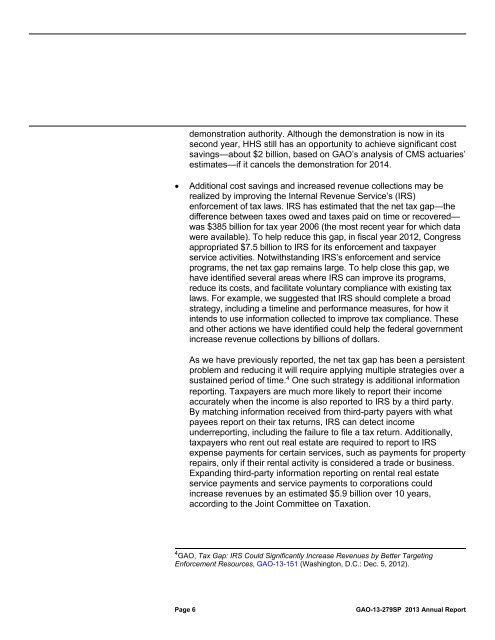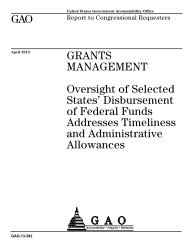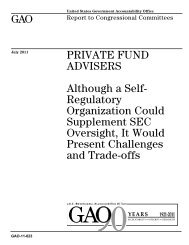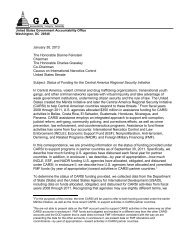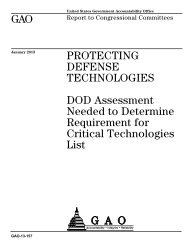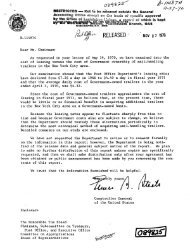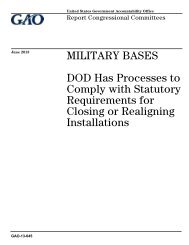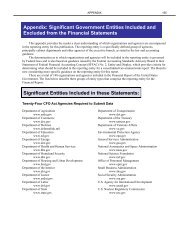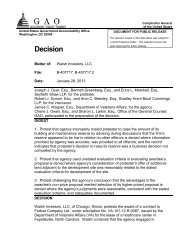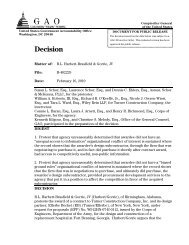- Page 1 and 2: GAO United States Government Accoun
- Page 3 and 4: Figure 1: Definitions of Fragmentat
- Page 5: efficiencies in fragmented contract
- Page 9 and 10: as maintaining roads and responding
- Page 11 and 12: overall effectiveness of the federa
- Page 13 and 14: The Executive Branch and Congress H
- Page 15 and 16: Consolidated areas and actions were
- Page 17 and 18: To help maintain attention on these
- Page 19 and 20: Our systematic examination required
- Page 21 and 22: information. In particular, we revi
- Page 23 and 24: of a comprehensive list of federal
- Page 25 and 26: data-driven reviews of their perfor
- Page 27 and 28: guide to help ensure that these con
- Page 29 and 30: Abbreviations AFF Assets Forfeiture
- Page 31 and 32: Report at a Glance Section I of thi
- Page 33 and 34: Mission Areas Identified Page Gener
- Page 35 and 36: Agriculture 1. Catfish Inspection R
- Page 37 and 38: GAO provided a draft of this report
- Page 39 and 40: Services’ Camouflage Uniforms, Da
- Page 41 and 42: military operations in different un
- Page 43 and 44: combat uniforms since they began se
- Page 45 and 46: Related GAO Products Warfighter Sup
- Page 47 and 48: What GAO Found DOD contracts for a
- Page 49 and 50: agencies in determining what produc
- Page 51 and 52: How GAO Conducted Its Work The info
- Page 53 and 54: party estimates indicate that feder
- Page 55 and 56: characteristics, and several of the
- Page 57 and 58:
expected reduction or avoidance of
- Page 59 and 60:
eport, where GAO recommended that i
- Page 61 and 62:
Health 5. Joint Veterans and Defens
- Page 63 and 64:
enefit from collaboration, such as
- Page 65 and 66:
Actions Needed GAO recommended in S
- Page 67 and 68:
6. Medicaid Program Integrity The C
- Page 69 and 70:
data resulted in a significant comm
- Page 71 and 72:
might not provide adequate data to
- Page 73 and 74:
processes and procedures for overse
- Page 75 and 76:
unnecessary duplication increases b
- Page 77 and 78:
Internal Control in the Federal Gov
- Page 79 and 80:
State and major urban area fusion c
- Page 81 and 82:
activities are uncoordinated, as we
- Page 83 and 84:
a Collection management is the iden
- Page 85 and 86:
c Analytical products involve the c
- Page 87 and 88:
However, GAO also reported in April
- Page 89 and 90:
highly dependent on local circumsta
- Page 91 and 92:
9. Justice and Treasury Asset Forfe
- Page 93 and 94:
consolidation proposals and activit
- Page 95 and 96:
of both agencies, which affects the
- Page 97 and 98:
Information Technology 10. Dissemin
- Page 99 and 100:
the reports GAO was searching for w
- Page 101 and 102:
NTIS acknowledged in its 2011-2016
- Page 103 and 104:
ased on random selections, its samp
- Page 105 and 106:
What GAO Found In November 2012, GA
- Page 107 and 108:
data themes, as shown in the follow
- Page 109 and 110:
designate a senior agency official
- Page 111 and 112:
How GAO Conducted Its Work The info
- Page 113 and 114:
Select Features and Limitations of
- Page 115 and 116:
SBA and other agencies could also b
- Page 117 and 118:
GAO assessed interagency coordinati
- Page 119 and 120:
Overlap of BBG Entities’ Language
- Page 121 and 122:
variety of factors, including wheth
- Page 123 and 124:
of capitalization grants to revolvi
- Page 125 and 126:
GAO’s October 2012 report also de
- Page 127 and 128:
purpose of this document is to summ
- Page 129 and 130:
Social Services 15. Drug Abuse Prev
- Page 131 and 132:
prevention or treatment services to
- Page 133 and 134:
minimize the risk of potential dupl
- Page 135 and 136:
22 more program evaluations were un
- Page 137 and 138:
How GAO Conducted Its Work The info
- Page 139 and 140:
Training, Employment, and Education
- Page 141 and 142:
education expenses. While many mean
- Page 143 and 144:
Considering these factors can help
- Page 145 and 146:
Related GAO Products Higher Educati
- Page 147 and 148:
significant barriers to employment,
- Page 149 and 150:
ut it does not consistently report
- Page 151 and 152:
Program. In examining coordination,
- Page 153 and 154:
Agriculture 18. Agricultural Quaran
- Page 155 and 156:
customs fee collection mechanisms t
- Page 157 and 158:
The Secretaries of Agriculture and
- Page 159 and 160:
19. Crop Insurance To achieve up to
- Page 161 and 162:
federal government. 4 If the limit
- Page 163 and 164:
How GAO Conducted Its Work The info
- Page 165 and 166:
GAO has continued to monitor DOD’
- Page 167 and 168:
will not be in the best position to
- Page 169 and 170:
Finally, DOD partially agreed with
- Page 171 and 172:
Energy 21. Department of Energy’s
- Page 173 and 174:
already exists in the commercial ma
- Page 175 and 176:
General Government 22. Additional O
- Page 177 and 178:
implementation of its data analytic
- Page 179 and 180:
GAO reported that the complexity of
- Page 181 and 182:
Higher Education: Improved Tax Info
- Page 183 and 184:
additional savings. 1 By contrast,
- Page 185 and 186:
Agency Comments and GAO’s Evaluat
- Page 187 and 188:
24. Opportunities to Help Reduce Go
- Page 189 and 190:
to identify opportunities and imple
- Page 191 and 192:
U.S. and foreign satellite operator
- Page 193 and 194:
plan to rely on foreign companies
- Page 195 and 196:
How GAO Conducted Its Work The info
- Page 197 and 198:
policies established by CMS or by l
- Page 199 and 200:
ased on their local coverage determ
- Page 201 and 202:
26. Medicaid Supplemental Payments
- Page 203 and 204:
Medicaid payment principles, in par
- Page 205 and 206:
GAO provided a draft of this report
- Page 207 and 208:
Demonstration extends the bonuses t
- Page 209 and 210:
Actions Needed and Potential Financ
- Page 211 and 212:
Homeland Security/Law Enforcement 2
- Page 213 and 214:
Based on data provided by TSA for G
- Page 215 and 216:
or a preference for funding initiat
- Page 217 and 218:
2007 as being a definitive statemen
- Page 219 and 220:
existing IT services to or offering
- Page 221 and 222:
ecause legacy systems may not be re
- Page 223 and 224:
30. Information Technology Operatio
- Page 225 and 226:
identifying investment improvements
- Page 227 and 228:
ecommendations and that the departm
- Page 229 and 230:
Examples of Cigarette and Cigar Pro
- Page 231 and 232:
cigars. In addition, Treasury faces
- Page 233 and 234:
Appendix I: List of Congressional A
- Page 235 and 236:
duplication government-wide over th
- Page 237 and 238:
of funding devoted to overlapping p
- Page 239 and 240:
means the administration, the agenc
- Page 241 and 242:
Table 1: GAO Identified Areas of Du
- Page 243 and 244:
Mission General government Annual r
- Page 245 and 246:
Mission Science and the environment
- Page 247 and 248:
Table 2: GAO Identified Areas of Co
- Page 249 and 250:
Mission Annual Report Areas identif
- Page 251 and 252:
Mission Income security Information
- Page 253 and 254:
Table 1: Catfish Inspection: List o
- Page 255 and 256:
Table 3: Renewable Energy Initiativ
- Page 257 and 258:
Agency Program name Fiscal year 201
- Page 259 and 260:
Table 5: Medicaid Program Integrity
- Page 261 and 262:
Table 7: Field-Based Information Sh
- Page 263 and 264:
Table 9: Export Promotion: List of
- Page 265 and 266:
Table 11: Rural Water Infrastructur
- Page 267 and 268:
subagency Program name Program desc
- Page 269 and 270:
subagency Program name Program desc
- Page 271 and 272:
Table 13: Higher Education Assistan
- Page 273 and 274:
Table 14: Higher Education Assistan
- Page 275 and 276:
Table16: Crop Insurance: Program an
- Page 277 and 278:
Table 18: Medicare Prepayment Contr
- Page 279 and 280:
Table 20: Checked Baggage Screening
- Page 281 and 282:
Table 22: Tobacco Taxes: List of Pr
- Page 283:
GAO’s Mission Obtaining Copies of


